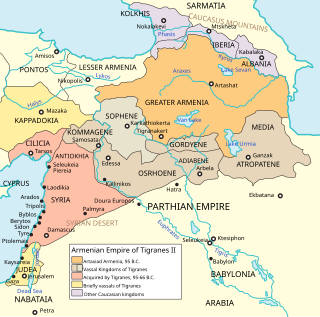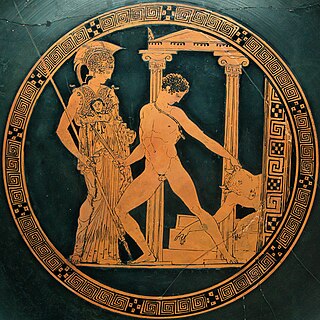Related Research Articles

Hadrian was Roman emperor from 117 to 138. Hadrian was born in Italica, close to modern Seville in Spain, an Italic settlement in Hispania Baetica; his branch of the Aelia gens, the Aeli Hadriani, came from the town of Hadria in eastern Italy. He was a member of the Nerva-Antonine dynasty.

Matthew the Apostle is named in the New Testament as one of the twelve apostles of Jesus. According to Christian traditions, he was also one of the four Evangelists as author of the Gospel of Matthew, and thus is also known as Matthew the Evangelist.

The Roman Empire was the era of Roman civilisation lasting from 27 BC to 476 AD. Rome ruled the Mediterranean and much of Europe, Western Asia and North Africa. The Romans conquered most of this during the Republic, and it was ruled by emperors following Octavian's assumption of effective sole rule in 27 BC. The western empire collapsed in 476 AD, but the eastern empire lasted until the fall of Constantinople in 1453.

The History of the Decline and Fall of the Roman Empire, sometimes shortened to Decline and Fall of the Roman Empire, is a six-volume work by the English historian Edward Gibbon. The six volumes cover, from 98 to 1590, the peak of the Roman Empire, the history of early Christianity and its emergence as the Roman state religion, the Fall of the Western Roman Empire, the rise of Genghis Khan and Tamerlane and the fall of Byzantium, as well as discussions on the ruins of Ancient Rome.

The 2nd century BC started the first day of 200 BC and ended the last day of 101 BC. It is considered part of the Classical era, although depending on the region being studied, other terms may be more suitable. It is also considered to be the end of the Axial Age. In the context of the Eastern Mediterranean, it is the mid-point of the Hellenistic period.
In Greek mythology, Erebus, or Erebos, is the personification of darkness. In Hesiod's Theogony, he is the offspring of Chaos, and the father of Aether and Hemera (Day) by Nyx (Night); in other Greek cosmogonies, he is the father of Aether, Eros, and Metis, or the first ruler of the gods. In genealogies given by Roman authors, he begets a large progeny of personifications upon Nox, while in an Orphic theogony, he is the offspring of Chronos (Time).

Osroene or Osrhoene was an ancient region and state in Upper Mesopotamia. The Kingdom of Osroene, also known as the "Kingdom of Edessa", according to the name of its capital city, existed from the 2nd century BC, up to the 3rd century AD, and was ruled by the Abgarid dynasty. Generally allied with the Parthians, the Kingdom of Osroene enjoyed semi-autonomy to complete independence from the years of 132 BC to AD 214. The kingdom's population was of mixed culture, being Syriac-speaking from the earliest times. The city's cultural setting was fundamentally Syriac, alongside strong Greek and Parthian influences, though some Arab cults were also attested at Edessa.

In ancient Greek religion and mythology, the twelve Olympians are the major deities of the Greek pantheon, commonly considered to be Zeus, Poseidon, Hera, Demeter, Aphrodite, Athena, Artemis, Apollo, Ares, Hephaestus, Hermes, and either Hestia or Dionysus. They were called Olympians because, according to tradition, they resided on Mount Olympus.

Docimium, Docimia or Docimeium was an ancient city of Phrygia, Asia Minor where there were famous marble quarries. The exact site of Docimium was a matter of some dispute until recently; it is now fixed at the modern Turkish town İscehisar, in Afyonkarahisar Province.

The Byzantine Empire, also referred to as the Eastern Roman Empire, was the continuation of the Roman Empire centred in Constantinople during late antiquity and the Middle Ages. The eastern half of the Empire survived the conditions that caused the fall of the West in the 5th century AD, and continued to exist until the fall of Constantinople to the Ottoman Empire in 1453. During most of its existence, the empire remained the most powerful economic, cultural, and military force in the Mediterranean world. The term "Byzantine Empire" was only coined following the empire's demise; its citizens referred to the polity as the "Roman Empire" and to themselves as "Romans". Due to the imperial seat's move from Rome to Byzantium, the adoption of state Christianity, and the predominance of Greek instead of Latin, modern historians continue to make a distinction between the earlier Roman Empire and the later Byzantine Empire.
Doara was a town of ancient Cappadocia, inhabited in Byzantine times. It was in the Chamanene prefecture created by Archelaus of Cappadocia during Hellenistic times. The town appears on the Peutinger Table between Caesarea and Tavium. It was also mentioned by Hierocles as Rhegedoara (Ῥεγεδοάρα), and the Notitiae Episcopatuum.
Maionia or Maeonia, was a city of the Hellenistic, Roman and Byzantine era located near the Hermos River, in ancient Lydia. Both Ramsay and Talbert tentatively identified the ancient polis with the modern village of Koula a village known for its carpet manufacture.
Kasossos was a town of ancient Caria. It evidently contained an important temple or sanctuary that was shown favour by the Hecatomnids when they ruled Caria. Its townspeople appear in ancient inscriptions recovered in Caria.
Proconnesus or Prokonnesos, also spelt Proeconesus or Proikonnesos (Προικόνησος), was a Greek town on the southwestern shore of Proconnesus island. Aristeas, the poet of the Arimaspeia, was a native. This town, which was a colony of the Milesians, was burnt by a Phoenician fleet, acting under the orders of Persian king Darius I. Strabo distinguishes between old and new Proconnesus. The inhabitants of Cyzicus, at a time which we cannot ascertain, forced the Proconnesians to dwell together with them, and transferred the statue of the goddess Dindymene to their own city.
Stectorium or Stektorion was a town of ancient Phrygia, in the Phrygian Pentapolis between Peltae and Synnada, inhabited during Roman and Byzantine times. Pausanias believed that Mygdon's tomb was located here.

Temenothyra, or Temenothyrae or Temenothyrai, was a town of ancient Lydia, or of Phrygia, inhabited during Roman and Byzantine times. It became a bishopric; no longer the seat of a residential bishop, under the name Temenothyrae it remains a titular see of the Roman Catholic Church.
Agatheira was a town of ancient Lydia, inhabited during Hellenistic times. Its site is located near Halitpaşa in Asiatic Turkey. This colony was called a katoikiai, along with Magnesia-by-Sipylus, Hyrcanis, and Thyateira. They were separated from one another by about 15 kilometres (9.3 mi).
Plarasa or Plarassa was an inland town of ancient Caria, inhabited during Roman times. At some point it, along with Tauropolis, became part of the territory of the Antiochia ad Maeandrum, after which an aqueduct which was built by Marcus Ulpius Carminius Claudianus in the 2nd century to supply the combined community.
Nora was a mountain fortress and town of ancient Cappadocia, on the frontiers of Lycaonia. Located at the foot of Mount Taurus, in which Eumenes was for a whole winter besieged by Antigonus (319 BC), before he escaped. In Strabo's time it was called Neroassus or Neroassos (Νηροασσός), and served as a treasury to Sicinus, who was striving to obtain the sovereignty of Cappadocia.
Anisa (Ανίσα) was a town of ancient Cappadocia, inhabited in Hellenistic, Roman, and Byzantine times. A source described Anisa as a politeumata, which was a township for privileged foreigners. Although it did not control any territory outside its jurisdiction, it enjoyed internal self-government.
References
- 1 2 Richard Talbert, ed. (2000). Barrington Atlas of the Greek and Roman World . Princeton University Press. p. 62, and directory notes accompanying. ISBN 978-0-691-03169-9.
- ↑ Ramsay, William Mitchell (2010). The historical geography of Asia Minor. Cambridge: Cambridge University Press. p. 237. ISBN 9781108014533.